- About Us
- Our Work
- Tree Info
- Get Involved
- Blog
- Support Us
By Maika Horjus on August 7, 2017
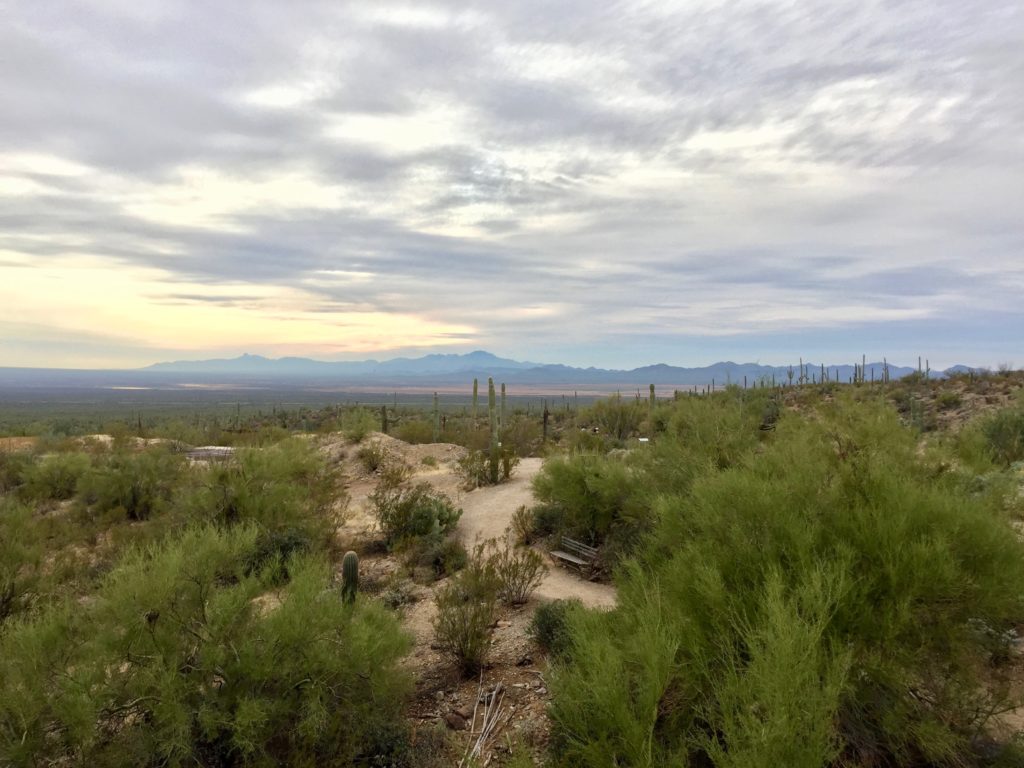
Sunset view from the Arizona-Sonora Desert Museum west of Tucson, AZ.
Welcome to the fourth installment of Canopy’s Summer Travel Series! New stories from the Canopy team published every other week.
This week, Director of Donor Engagement Maika Horjus heads south to the Sonoran desert near Tucson, AZ to check out some “otherworldly” desert survivors.
P.S. Are you traveling this summer? We’d love to see your tree photos and hear your stories! Email to [email protected] or tag us on Facebook or Instagram.
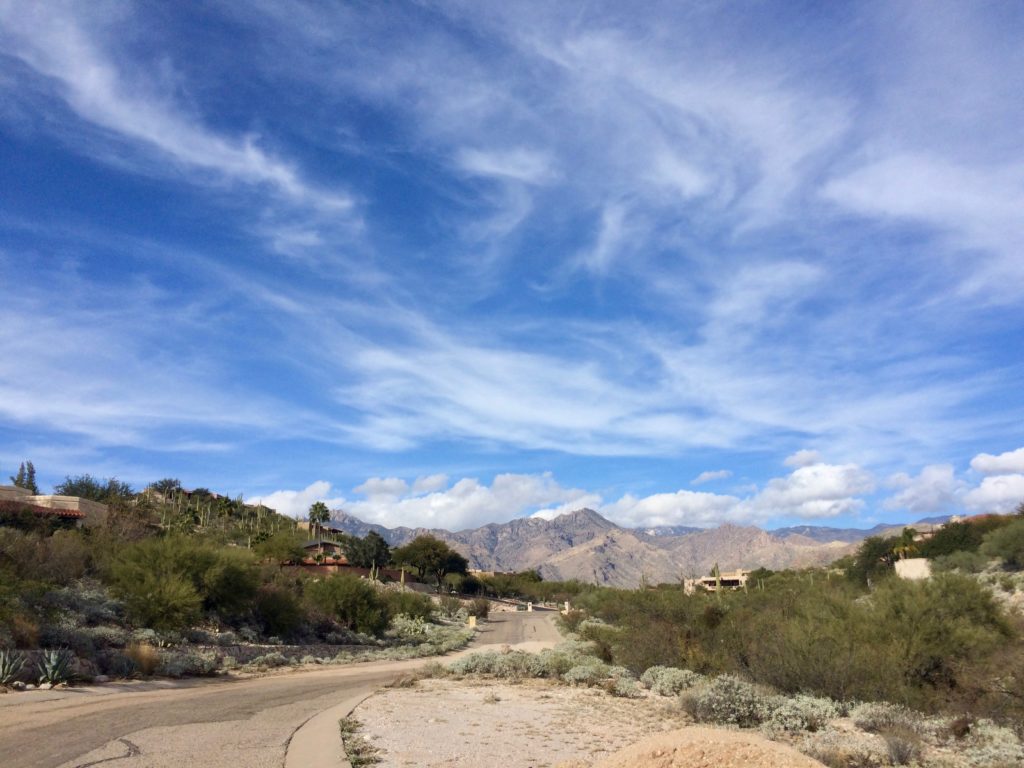
Walking around my in-laws’ sunny neighborhood in the Catalina Foothills of Tucson, Arizona.
A few times each year, my partner Jim and I make our way to Tucson, Arizona where Jim’s parents (after three decades braving the harsh winters and weather vagaries of Chicago, IL) recently decided to retire to warmer climes.
It’s a beautiful landscape, with its rolling hills and stately saguaros, and it’s one of my favorite places to visit during cool winter months. Jim’s parents live in the Catalina Foothills northeast of the city, and there is nothing like watching the sun rise or set over the painted desert hills.
Last time we visited, we took a trip to the Arizona-Sonora Desert Museum (ASDM) on the far west edge of Tucson. This magical destination is a hybrid of a museum, a zoo, and a botanical garden, and it’s a veritable paradise for any biophilic plant geek.
Desert plants always remind me of ocean creatures. Cactuses, chollas, and yucca—just like anemones, sea urchins, and coral reefs—make me think of strange organisms from another world.
And that’s sort of what they are, after all; the extreme environmental conditions of the desert or the deep ocean are a world of their own, and the flora and fauna that live there have evolved all sorts of unique adaptations to survive.
Walking through the desert museum, I thought of a quote from biologist Hope Jahren’s book Lab Girl: “A cactus doesn’t live in the desert because it likes the desert; it lives there because the desert hasn’t killed it yet.”
Cactuses aren’t the only plant that defies the desert heat to survive and thrive, however. There are plenty of trees that make their home in the Sonoran desert, too, and I was fascinated to meet some of these arboreal desert survivors:
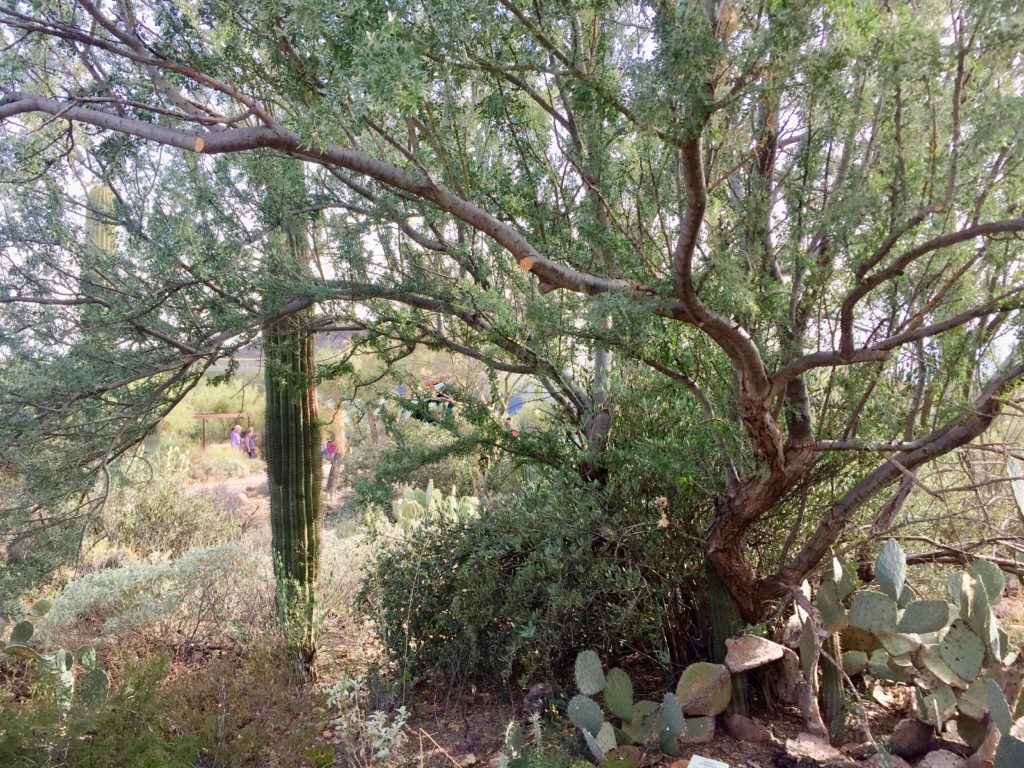
The term “Ironwood” has been applied to a diversity of trees that share the characteristic of very hard wood. The Desert Ironwood is notable as the only species in its genus, however, and it is found almost exclusively in the Sonoran Desert region.
Like the Mesquite trees (Genus Prosopis), another staple of the desert landscape, the Desert Ironwood is a legume. Both its flowers and seeds are edible and are said to have a vaguely peanutty flavor. Since flowering and fruiting require significant resources from the tree, however, many Desert Ironwoods do not bloom every year, and the abundance of flowers and fruit will vary considerably depending on rainfall and temperature patterns.
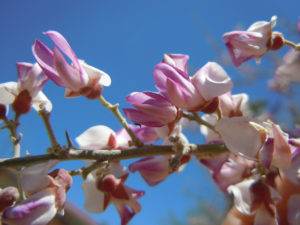
I have yet to visit Tucson in the spring, so I’ve never seen the beautiful blossoms of the Desert Ironwood, which can range from white to purple to golden yellow. Photo courtesy of Matt Lavin
Desert Ironwoods are relatively long-lived trees (300-800 years), but you may not realize you are eyeing an ancient being; they are very slow growers, for much the same reason that they may not flower every year. Ironwoods, like most desert plants, are very frugal. By maintaining a slow rate of photosynthesis, they make better use of every last drop of soil moisture available.
The Desert Ironwood’s slow-growing habit is partly responsible for another of its most notable features: its wood is among the hardest, densest, and heaviest of any tree on the planet. So dense, in fact, that it doesn’t even float in water!
This denseness, along with particular chemicals produced by the tree, make its wood extremely rot-resistant and nearly non-biodegrable. True to their name, dead Ironwoods can stand sentinel for centuries; some dead specimens have been know to stand for as long as 1,600 years without decaying.
Its durability also makes it attractive for firewood and wood carving, although harvesting is limited throughout Arizona and Sonora, since the tree is now protected.
Ecologically, the Desert Ironwood is considered a “nurse plant” and keystone species because of its influence on the surrounding landscape and habitat. Like other legumes, Ironwoods “fix” nitrogen and channel other nutrients into the soil, improving conditions for itself and its neighbors. It some areas, the Desert Ironwood is the only large, branching woody plant that grows, providing an important source of shade, food, and habitat to nearby flora and fauna.
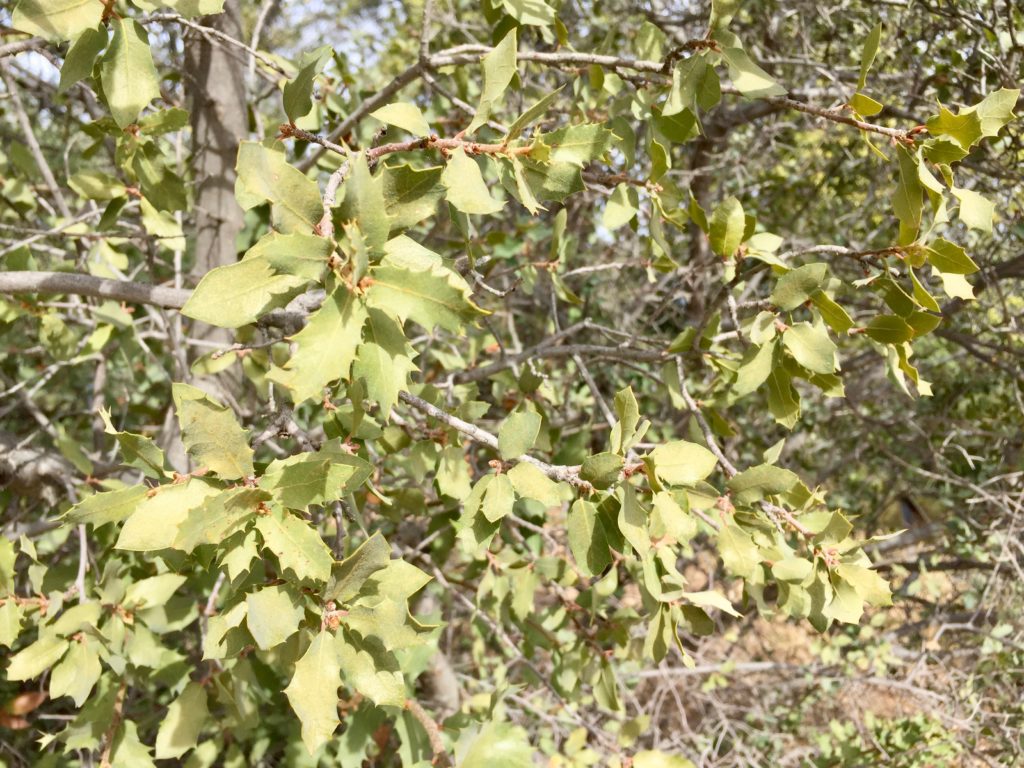
Identifying characteristics of the Shrub Oak include holly-like leaves and a stature that is, well…shrubby.
Our beloved California native oaks are among over 600 oak species throughout the world. The Sonoran desert area is home to about 21 of these species.
The evergreen Shrub Live Oak is one of the four most common oaks in Arizona (along with Emory, Silverleaf, and Arizona White Oak). Acorns of the shrub oak and other oaks were gathered by native peoples like the Yavapai, Pima, and Tohono O’odham and used for food, tea, and medicine.
Like many trees and shrubs in Arizona, the Shrub Oak has very small leaves. This trait is called microphylly, and is common in desert plants—something to do with the physics of heat dissipation and minimizing water loss from transpiration. If you have a clear understanding of how this works, please call and explain it to me!
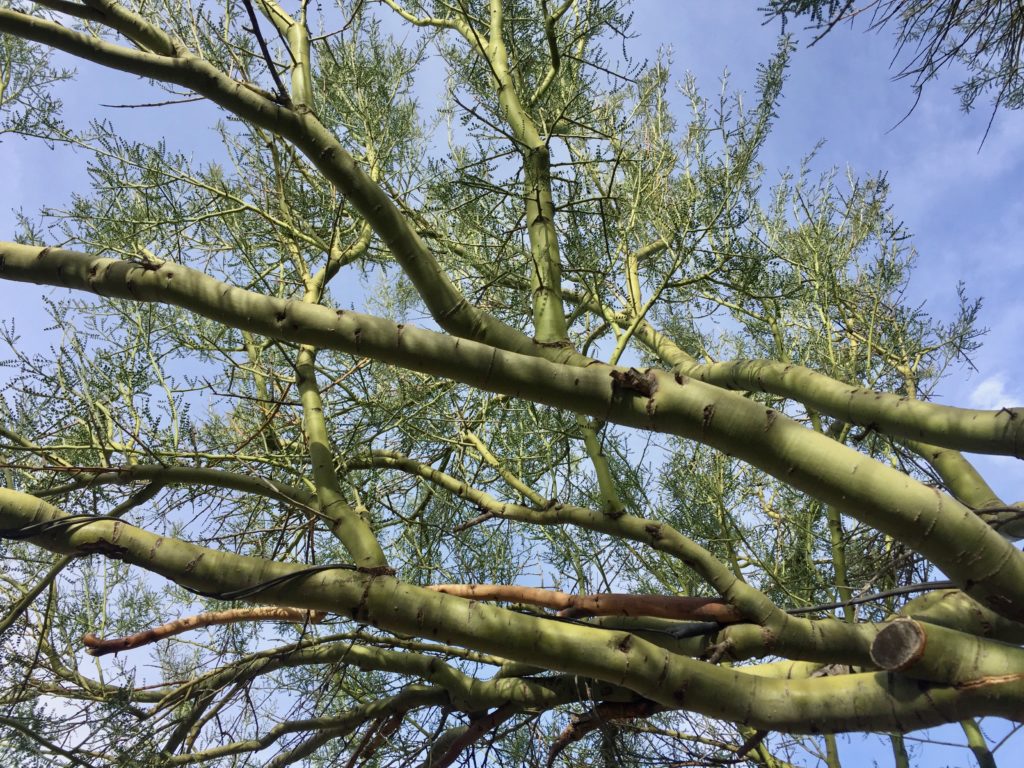
With a common name that means “green stick” in spanish, the Palo Verde is easily recognizable by its characteristic blue-green bark. Since Palo Verde trees drop their leaves for much of the year or in response to prolonged drought, the green twigs and branches serve an important function, performing photosynthesis for the tree even when it has no leaves. According to the Arizona Native Plant Society, nearly three quarters of the trees’ food is produced by the bark, and only a quarter by its leaves.
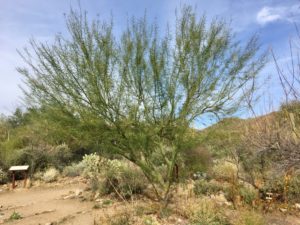 There are around a dozen species of Palo Verde in the world, and the Desert Museum features their own special cultivar called (appropriately) ‘Desert Museum’ Palo Verde. A 2011 blog post from the LA Times mentions the story of how, “three decades ago the director of natural history [at the ASDM], Mark Dimmitt, identified a thornless seedling that would not just flower in the spring, but would keep blooming throughout the summer.” They propagated the tree through cuttings, and it has now become a favorite drought-tolerant ornamental tree in cities from Tucson and Phoenix to LA and Las Vegas.
There are around a dozen species of Palo Verde in the world, and the Desert Museum features their own special cultivar called (appropriately) ‘Desert Museum’ Palo Verde. A 2011 blog post from the LA Times mentions the story of how, “three decades ago the director of natural history [at the ASDM], Mark Dimmitt, identified a thornless seedling that would not just flower in the spring, but would keep blooming throughout the summer.” They propagated the tree through cuttings, and it has now become a favorite drought-tolerant ornamental tree in cities from Tucson and Phoenix to LA and Las Vegas.
It is the native Foothill Palo Verde and Blue Palo Verde, however, that share the honor of being Arizona’s state tree.
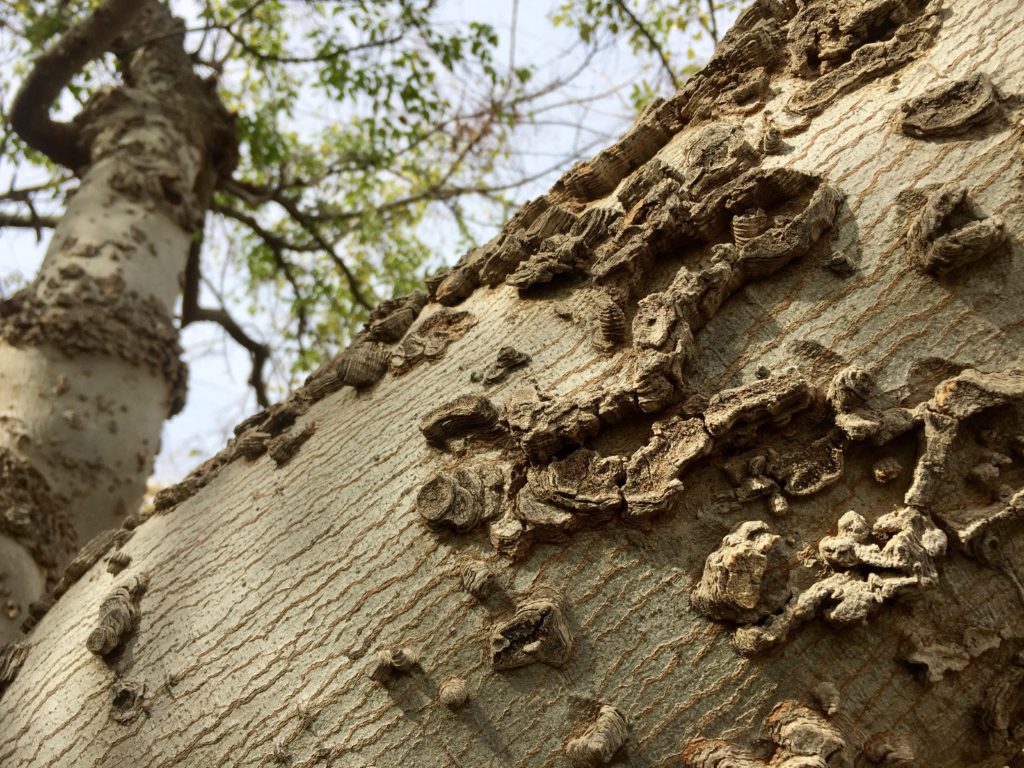
The distinctive “corky” ridges on its grey-brownish bark help identify the Canyon Hackberry (Celtis reticulata)

It’s no secret how these lovely trees got their name. White Bark Acacia (Mariosousa willardiana) are endemic to the thorn scrub of Sonora.

The Boojum (Fouquieria columnaris) was supposedly so named in 1922 by Mr. Godfrey Sykes of Tucson’s Desert Botanical Laboratory, who apparently had a sense of humor. When he first spotted the tree on a hillside through his telescope from afar, he reportedly exclaimed, “Ho, ho, a boojum, definitely a booojum”–a reference to a legendary mythical creature in Lewis Carroll’s story, Hunting of the Snark.